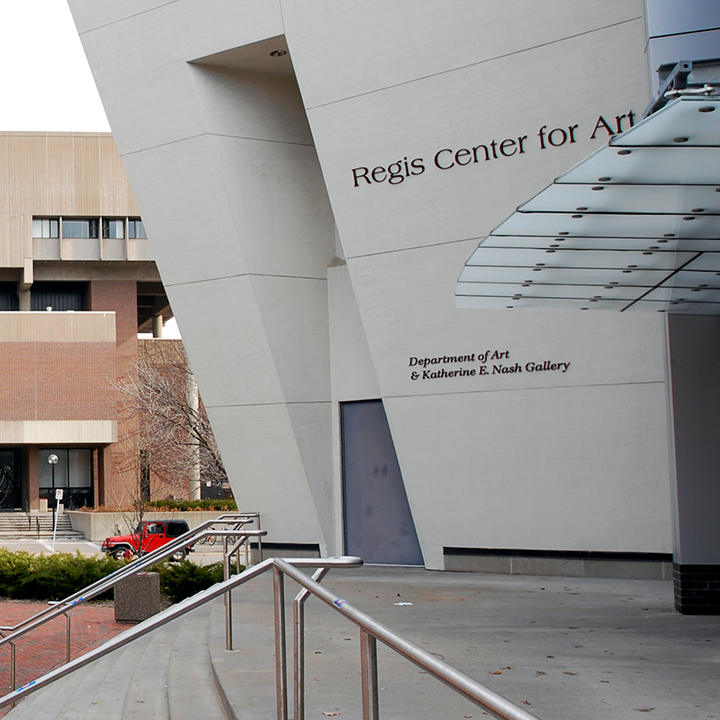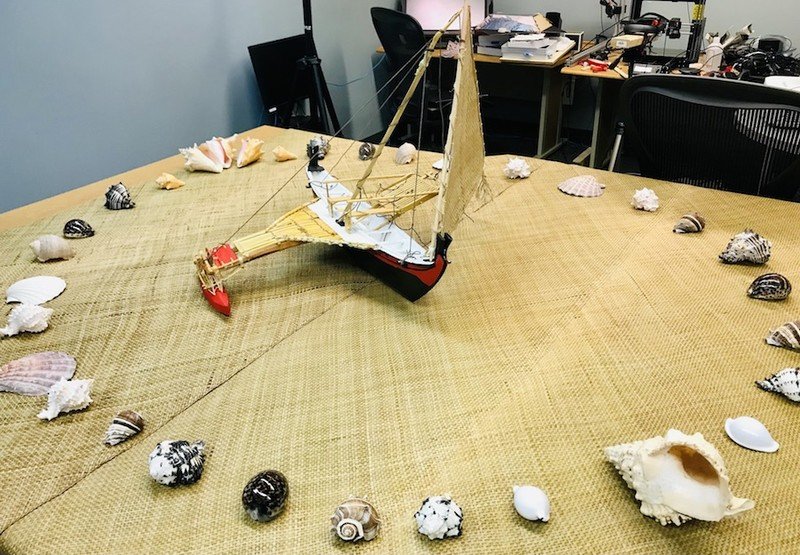Research studio to put art first—with the help of science and technology

Top: CS&E Professor Dan Keefe partnered with CLA Professor Vicente Diaz on this art installation—pairing seashells, a canoe, and virtual reality—that will open on Thursday, Sept. 16 in the Northrop Gallery. Photo credit: Dan Keefe
CS&E faculty involved in creating collaborative ArTeS space
Lana Yarosh first started working with Diane Willow seven years ago. The pair, associate professors at the University of Minnesota College of Science and Engineering and College of Liberal Arts respectively, started a group called the Internet of Things Collaborative on the Twin Cities campus with the goal to get both science and art students engaged with technology.
Back then, they had limited resources. Yarosh and Willow spent one day each week wheeling a shopping cart full of assorted gadgets—like 3D printers and Arduino computing boards—to different locations on campus, trying to get students involved and collaborating with each other. Their efforts eventually morphed into an official student group.
“While the science and engineering students came to these workshops with a lot of technical skills, it was really the arts and humanities and design students who were bringing the innovative and exciting ideas,” said Yarosh, a Distinguished University Teaching Professor and McKnight Presidential Fellow in the Department of Computer Science and Engineering (CS&E).
“They might not have known exactly how to make the idea, but when we put them together with engineering students, it was like magic,” said Yarosh. “They were learning from each other, and it was amazing and exciting.”
Internet of Things is just one example of the interdisciplinary collaborations that Willow, a faculty member in the Department of Art, has catalyzed over the last decade with researchers from various fields including design, architecture, and American Indian Studies to name a few. Now, Willow’s efforts are coming together to form a physical space—the ArTeS Collaborative Research Studio.
The studio name is derived from the three areas it brings together: Art, Technology, and Science. Opening in the University of Minnesota Regis Center for Art in spring 2022, the ArTeS studio aims to be a place where students, researchers, and faculty from all three disciplines can use a wide array of technologies to create art and conduct research through a more creative lens.
Putting the ‘art’ in ArTeS
While many CSE faculty have their own labs, there aren’t as many spaces at the University for research in the arts, especially interdisciplinary research between CSE faculty and their CLA counterparts. The ArTeS studio will provide technology like computers, motion capture equipment, projectors, speakers, and sound equipment to support projects like dance performances and art displays.
“Traditionally, our funding and research spaces are geared toward our arts supporting and informing the technology,” said Dan Keefe, a Distinguished University Teaching Professor in the CS&E department and a key player in the ArTeS collaboration.
“This [new initiative] is very intentionally a space where the goal is to do the opposite—to lead with the arts and have the science and technology provide the medium for artistic expression,” Keefe said. “And in the process of that, we’re also going to expose the scientists to a new way of thinking through the arts.”
Keefe leads the Interactive Visualization Lab, where his research centers on data visualization, computer graphics, and 3D modeling in virtual reality. His work often blends art with science.
One project in particular that will likely use the ArTeS space is the University of Minnesota’s Native Canoe Program, led by American Indian studies associate professor Vicente Diaz. As part of the program, Keefe is collaborating with Diaz on an art installation that demonstrates how Micronesian seafarers navigated using constellations and the sun.

The display includes a Paafu mat made by Micronesian craftspeople coupled with a digitally augmented map of the stars and wave patterns. It will be part of the "Why Canoes?" series, currently in Northrop Gallery. On Thursday, September 16, the Micronesian community from Milan, Minn. will participate in an opening event for the mat's exhibit—plus tour Keefe's virtual reality labs and other University art studios. The installation will travel to the Asian Pacific Triennial art exhibit in Queensland, Australia later this year.
A space for all
In addition to being a space for more local collaborations—among Minnesota researchers, artists, and community members—the faculty leading the ArTeS initiative also envision a potential artist-in-residency and student-led projects.
Once the space opens, Yarosh sees her role as connecting students from different majors and colleges with each other so they can work on interdisciplinary, creative projects there—be that through a class or in their own free time.
“To me, it's about breaking down those walls within the University and within students’ minds that this is art and this science and the two shall never meet,” she explained.
“Almost making them think back to the way they thought in kindergarten where everything was in one classroom and you just did stuff you were excited by.”
While ArTeS is putting the arts first, according to Keefe, science and engineering students will absolutely benefit from using the space.
“In the STEM fields, we do a really good job of developing technical skills,” he said. “We do not do as good of a job of helping students and industries understand how the technology interacts with society—what technologies they should develop, who benefits from those technologies, and who might be oppressed through those technologies. These are things that artists, humanists, and other folks on campus teach all the time.”
“Art helps us make sense of the role of technology in society,” Keefe added. “I think to create a space where the intention is to bring this to the forefront is super powerful, and it just doesn’t exist anywhere else.”
In addition to Willow, Keefe, Yarosh, and Diaz, other University of Minnesota collaborators involved in the ArTeS initiative include Sumanth Gopinath (School of Music), Virajita Singh (College of Design and Office for Equity and Diversity), Colin McFadden (LATIS). Former U of M faculty member Jennifer Newsom, who is now at Cornell University, was also a key collaborator.
Story by Olivia Hultgren